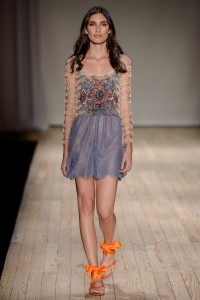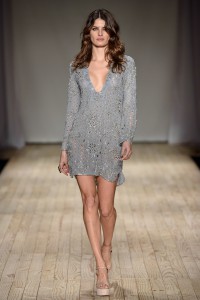From Minas Gerais to the world: all about the Fabiana Milazzo brand
Eveningwear, embroidery, sparkle and colors. You could say that Fabiana Milazzo, the Minas Gerais designer who founded her eponymous brand in 2000, specializes in reinventing such Brazilian characteristics in richly crafted apparel items. Since 2013, the Uberlandia-based brand has been a member of Texbrasil, the Brazilian Fashion Industry Internationalization Program, developed by Abit and Apex-Brasil (Brazilian Trade and Investment Promotion Agency). The label started out in the Program with the clear goal of growing its international presence, and from then until now, it has gained 15 international points of sale, in addition to its 90 points of sale in Brazil. Below, Leticia Manzan, Fabiana’s right hand at the company, talks a bit about the brand’s path to conquering the international market.
Texbrasil: When did the company decide to start exporting products?
Letícia: We had already sold some items to international buyers at the Minas Trend showroom, but we only decided to make a serious investment in exporting after taking part in a course that showed how important it is to diversify markets. That was when we found out about Abit and the work of Texbrasil and decided to take the first step. We now sell in 15 international stores, including Luisa Via Roma (Italy), Les Suites and Battaglia (France), Jean et Jeanne (Japan) and SAXA Store (Ireland). Our main market, however, is not Europe, but rather is in the Middle East, where we are at Green Bird (Abu Dhabi), Ginger & Lace (Dubai and Kuwait) and Per Lei Couture (Qatar).
Where do you most want to consolidate?
Our main target market is currently Asia. We believe in the purchasing power of the Chinese and Japanese and we want to take advantage of their interest in things from abroad to introduce our product, especially after taking the Bunka Fashion College course.
What did you most enjoy in this course? What did you learn that you intend to apply to business?
We were fascinated with understanding how people can have such a different tradition than our own and at the same time be so welcoming. The Japanese are very good at everything they do; they try to outdo themselves daily and to develop new technologies to improve people’s lives. It is this example that inspires us.
What do you consider to be the biggest difference between the national and international markets?
One of the most important characteristics a brand should have its power to adapt. We always have to modify our products for Middle Eastern tastes, which are very different from what people like in Brazil. We usually make dresses longer, we sew on sleeves, we raise the neckline, among other things.
What advice would you give to companies that want to export?
We always hear that the export process is difficult, and it really is. Yet we are happy to say that we have achieved our space. For us, it was very important that the brand was mature in the national market before we began this process. We sold in retail and in wholesale for five years until deciding to sell abroad. For example, the Europeans and Asians demand impeccable garments; they do not accept any errors in the model or in manufacturing. All of these years understanding the Brazilian market were great to achieve a better product.




